A massive programme of investment in Thailand’s infrastructure, designed to enhance international connectivity and competitiveness, is set to be implemented this year amid a renewed commitment to investment and regional development.
The government is lining up 55 projects worth Bt2.27trn ($76.27bn) to be executed by 2020, with Bt100bn ($3.36bn) allocated in the 2013 fiscal year, the local press reported on January 18. The projects come under the government’s long-term development plan, but are being accelerated due to new commitments to investment and regional development, including liberalisation in neighbouring Myanmar, and the roll-out of the ASEAN Economic Community (AEC). The AEC has set a goal of regional economic integration, with the focus on creating a competitive single market integrated both internally and within the global economy.
“The infrastructure development projects are designed to make Thailand the true centre stage of ASEAN,” said Chadchart Sittipunt, the minister of transport. “Under this plan, Bangkok will no longer singly represent Thailand. Major cities will gain greater prominence, thanks to the AEC, which will […] extend regional connectivity.”
The Ministry of Finance is expected to present a plan to Cabinet to borrow Bt2.2bn ($73.91m). If given the green light, 64% of this figure will be allocated to 31 railway projects, 24% to 13 road schemes, 7% to seven water transport projects and 5% to four air transportation development ventures.
The aim of the investments is to improve Thailand’s connectivity with its ASEAN neighbours, boost trade, lower transportation costs, ease existing bottlenecks, and support the growth of the crucial tourism sector. By developing alternatives to road transport, Thailand also hopes to lower its carbon emissions.
Thailand lies at the heart of South-east Asia, a region which has enjoyed strong economic growth in recent years, and has recovered from the global economic crisis considerably more quickly than countries in Europe and North America. As well as the AEC, Thailand is a participant in a number of other regional bodies intended to support growth and integration, including the Bay of Bengal Initiative for Multi-Sectoral Technical and Economic Cooperation and the Ayeyawady-Chao Phraya-Mekong Economic Cooperation Strategy.
Important transportation corridors that are likely to be the focus of infrastructure investment include the Southern Economic Corridor (from Bangkok to Phnom Penh in Cambodia and Ho Chi Minh City in Vietnam) and the North-South Economic Corridor (linking Thailand with Laos, Myanmar and China, and terminating in the Chinese city of Kunming).
Chandchart said that he aimed to increase the use of railways from a 12% share of the transport sector to 40%, and four high-speed rail projects worth Bt900bn ($30.24bn) will be among the first to be rolled out under the plans. However, the government is not only committing money, it is also looking to restructure the State Railway of Thailand (SRT) to improve services and increase administrative capacity.
Investments in airports will take some of the pressure off Bangkok’s Suvarnabhumi Airport, which currently accounts for 72% of airport arrivals, said Chadchart, who suggested that the airport at Mae Sot, a trading centre on the Myanmar border, could be developed.
While the transportation plans are certainly capital-intensive, the minister said financing would be available through 3% government bonds as well as other revenue streams, and that the economic benefits of transport development would pay off the cost in the longer term. There should also be considerable scope for private investors as well as contractors, as public-private partnerships are expected to account for 14% of the total spent; this proportion could increase, thus lowering the burden on the public purse.
Foreign investors are expected to play a leading role, and Japanese Prime Minister Shinzō Abe has reportedly already expressed interest in Japanese firms’ participating in tenders, particularly for the upcoming high-speed rail projects. Chinese officials have shown strong interest in the rail links to Chiang Mai and Nong Khai, as they will eventually connect to the Chinese network.
With such large investments planned, Thailand has shown a commitment not only to overhauling its own transportation infrastructure but to greater connectivity in the region. However, for the AEC to succeed, new railways and roads need to be partnered with a renewed commitment to freer trade and economic liberalisation, including lowering tariff and non-tariff barriers and legislation restricting foreign investment. Thailand has one of the more liberal economies in the region, but across ASEAN, there is still some way to go before the ideal of an integrated economy open to globalised world markets is achieved.

